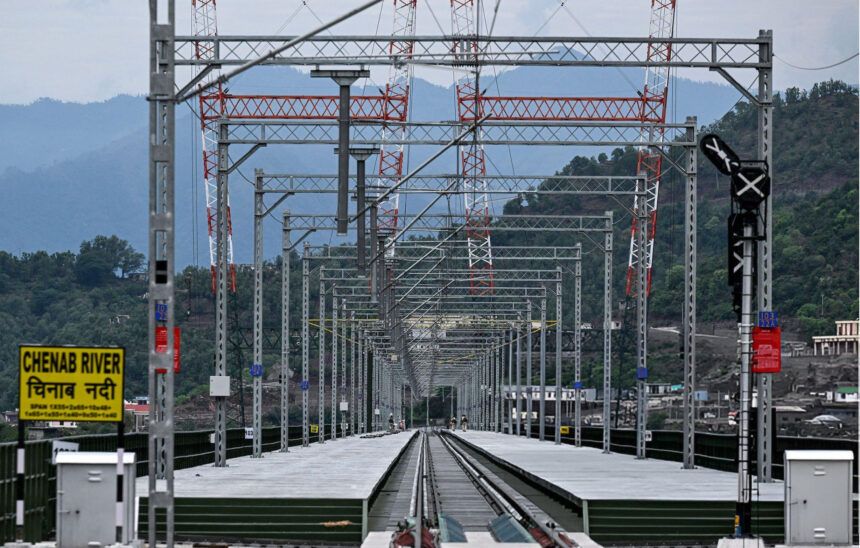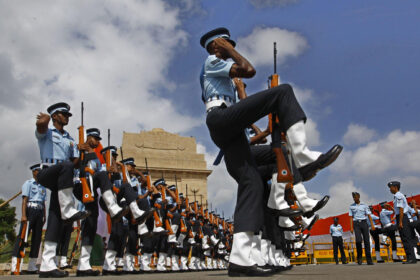Soaring 359 meters above the Chenab River gorge, the Chenab Rail Bridge is more than just a structure; it’s a striking declaration of what’s possible with modern engineering in even the most challenging environments. This in-depth guide will delve into its design, construction, strategic significance, and its importance, not just to engineers, but to every Indian.
1. Setting the Stage: What Makes Chenab Unique?
- Height: At 359 m (1,178 ft), it’s 35 m taller than the Eiffel Tower, and holds the title of highest and highest railway arch bridge in the world.
- Length & Span: Total length is 1,315 m, including a 467 m main arch span—the longest steel rail-only arch span globally.
- Engineering Records: With 17 spans and the central arch, it rewrote global bridge standards.
- Deck Width: Designed for dual railway tracks, with a 14 m deck and a 1.2 m central verge.
2. Why Build It Here? Terrain, Strategy & Vision
2.1 Breaking the Mountain Barrier
Part of the Udhampur–Srinagar–Baramulla Rail Link (USBRL)—an ambitious 272 km project designed to bring all-weather rail access to Kashmir, this section posed massive challenges:
- Over 750 bridges and 100 km of tunnels, stretching through the unforgiving Pir Panjal Range.
- The Chenab gorge—carved into young Himalayan rock, with unstable formations and high seismic activity.
2.2 Strategic Significance
- Year-round Connectivity: Reduced travel time from 6–7 hrs to about 3 hrs between Katra and Srinagar.
- Security Advantage: A robust rail link enables faster troop movement and supplies to border areas.
- Economic & Social Access: Opens new commerce, tourism pathways, and agricultural channels for Kashmir.
3. Masterful Design: Engineering Against Nature
3.1 Steel Frame & Concrete Backbone
- Utilizes ~30,000 t steel and over 46,000 m³ concrete, set in a composite steel box-arch—designed for durability.
- Deck built with a ballastless track system on concrete slabs with shock absorbers—ideal for high-altitude stress.
- Designed for a 120-year lifespan.
3.2 Blast, Wind & Earthquake Resilience
- Resistant to gusts of up to 266 km/h (160 mph)—based on wind-tunnel tests by Norway’s Force Technology Lab.
- Earthquake-proof to magnitude 8 with seismic design based on Zone V standards.
- Includes blast-proof components, heavy-duty platforms, and pillars tested to survive 40 t TNT-level explosions.
4. Climbing the Heights: Construction Tactics
4.1 Remote Terrain Logistics
- Accessible mostly by mules, horses & porters until temporary roads and tunnels were built.
- On-site labs, workshops, power plants, and worker camps were vital for this remote mega-project.
4.2 Building the Arch
- Used cable cranes spanning 900 m between cliffs and incremental deck launching over curves—a pioneering technique.
- Project involved 300+ engineers and 1,300 workers under Konkan Railway and Afcons, with design software like Tekla, STAAD, and Bentley OpenBridge suite.
5. From Blueprint to Reality: Project Timeline
| Phase | Details |
| 1983 | USBRL foundation stone laid |
| 1997–2003 | Alignment studies; bridge approved under Vajpayee gov’t |
| 2005–2014 | Udhampur–Katra & initial tunnel work completed |
| 2017 | Pier structures finalized; arch assembly begins |
| April 2021 | Arch capstone joined |
| Aug 2022 | Full bridge completed |
| June 2024 | Trial runs began |
| 6 June 2025 | Official inauguration by PM Modi alongside Vande Bharat launch |
6. Investment & Challenges: Behind the Numbers
- Chenab Bridge Cost: ₹1,486 crore (~USD 185 million).
- Total USBRL Project Cost: ₹43,780 crore (~USD 5.5 billion), includes many tunnels & bridges.
- Delays & Litigation: Initial completion by 2009 pushed to 2025 due to logistics, legal challenges, and land clearances.
- Material Suppliers: 12,000 t of steel sourced from SAIL’s Bhilai Plant was critical for structural integrity.
7. Socio-Economic & Strategic Benefits
7.1 Enhanced Mobility & Trade
- Holiday pilgrim trains to Vaishno Devi–Katra, and broader Kashmir travel, now under 3 hrs with Vande Bharat services.
- Better movement of agriculture, handicrafts, and tourism across Jammu & Kashmir.
7.2 Defense & Security
- Year-round logistical access to border regions; critical in mountain emergencies and security deployments.
7.3 Symbolic Progress
- Seen as a crown jewel of New India—melding technology, vision, and national unity.
- Bridge height compared to global structures: Eiffel Tower, Qutub Minar, and others.
8. Technological Firsts & Global Comparisons
- Longest steel railway arch span at 467 m—tops structures like China’s Najiehe Bridge.
- Wind resistance of 266 km/h—comparable to Millau Viaduct (France) and long-span bridges worldwide.
- Endurance rating of Zone V seismic strength and 120-year design life outpaces most existing arch railway bridges.
- Future-proof engineering—detects damage and continues safe train passage.
9. Watch the Marvel Take Shape
Want to see how this marvel stands tall against the Himalayan backdrop? Our YouTube video, titled “Chenab Rail Bridge 🇮🇳 World’s Tallest Railway Arch | Defying Gravity at 359 m!”, offers information that brings these facts to life.
👉 Watch it here: The Vue Times YouTube Video 💡
10. What’s Next?
- High-speed freight and eventual electrification promise even more utility.
- Tourism boom—locals predict thousands of visitors flock to view this bridge each year.
- Anji Khad Cable-Stayed Bridge—another engineering poster project being built nearby.
FAQs: Your Top Questions Answered
Where is the Chenab Rail Bridge located?
Between Bakkal and Kauri stations in Reasi, J&K.
How tall is it compared to the Eiffel Tower?
359 m vs Eiffel’s 324 m—so it’s 35 m taller.
What materials were used?
~30,000 t steel, 46,000 m³ concrete; sourced in part from SAIL Bhilai.
How resilient is it?
Designed for seismic zone V standards, wind speeds ~266 km/h, and blast resistance to 40 t.








